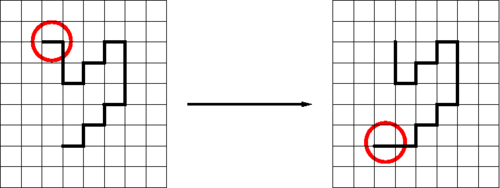Monte Carlo reptation moves: Difference between revisions
Jump to navigation
Jump to search
mNo edit summary |
Carl McBride (talk | contribs) m (Added an image.) |
||
| Line 1: | Line 1: | ||
{{Stub-general}} | {{Stub-general}} | ||
'''Reptation moves''' are also known as the "slithering snake" model. | '''Reptation moves''' are also known as the "slithering snake" model. One [[Random numbers | randomly]] chooses one of the two ends to become, on this occasion, the head of the snake. One then removes a piece of its tail, and after another random selection between freely available sites, one tacks on a new section to become the head of the snake. For example: | ||
<br>:[[Image:Reptation.png|500px]]<br> | |||
==See also== | ==See also== | ||
*[[Configurational bias Monte Carlo]] | *[[Configurational bias Monte Carlo]] | ||
Revision as of 16:20, 17 May 2010
Reptation moves are also known as the "slithering snake" model. One randomly chooses one of the two ends to become, on this occasion, the head of the snake. One then removes a piece of its tail, and after another random selection between freely available sites, one tacks on a new section to become the head of the snake. For example:
